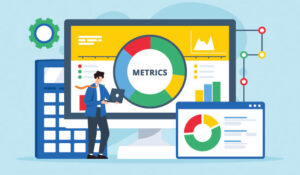In the modern contact centre, you can track virtually every aspect of your operations, from agent performance to customer behaviors. With so many call centre metrics available, how do you know which ones to focus on?
This abundance of data can be a double-edged sword. On the one hand, you’ve got almost complete visibility into your organization.
On the other hand, you’re processing so much information that it can quickly get overwhelming.
The key is finding the metrics that matter for your business aims. While you’re likely aware of the big hitters, we’re going to dig deeper and focus on some lesser known contact centre metrics that can offer fresh insights.
What Are Call Centre Metrics?
We use metrics to measure the overall success of a call centre, or home in on aspects such as customer support, agent productivity, and operational efficiency. Metrics can help managers and supervisors meet goals, or showcase strong performance for the C-suite.
The metrics you track will depend on your specific aims. Traditionally, contact centres have prioritized service metrics like customer satisfaction score (CSAT), Net Promoter Score (NPS), and customer effort score (CES).
Why Do You Need to Track Metrics in Your Call Centre?
Tracking contact centre metrics allows you to determine the success of your organization across multiple departments and functions. This process offers insights into every aspect of your operations.
Ensure Accountability
It’s hard to argue with numbers. Metrics provide managers with black-and-white evidence of performance levels, which they can use to encourage greater accountability throughout their workforce.
Evaluate Agent Performance
Through analysis of call centre metrics, you can easily evaluate agent performance. These evaluations can provide valuable insights into every aspect of agent performance and inform training strategy.
Increase Productivity
The success of your contact centre hinges on the productivity of your agents. Metrics like average handle time, service level, and agent utilization rate can help identify process issues and inefficiencies that are holding you back.
Allow for Healthy Competition
The idea that “a little healthy competition never hurt anyone” holds true in the call centre environment. By tracking metrics for individual agents, teams, or departments, you can create a leaderboard and challenge your employees to outperform one another.
Improve Customer Experience
With seven out of 10 customers reporting that they have stopped doing business with a brand after a poor experience, it’s essential that you measure the impact of your CX. Metrics like CSAT, NPS, and first call resolution are directly linked to customer experience.
Optimize Resources
A key aspect of a successful call centre is effective management of resources. By tracking metrics like service level, average wait time, and transfer rate, you can identify areas where resources are poorly allocated and make necessary changes.
Minimize Compliance Risks
Lapses in regulatory compliance can lead to lawsuits, hefty fines, and significant damage to your brand’s reputation. Using evaluation tools like QA scorecards you can ensure agent adherence and protect your organization.
Reduce Costs
By monitoring metrics like average speed of answer, average handle time, and average after call work time, you can identify cost inefficiencies. In conjunction with customer service metrics, this will allow you to become more cost efficient without sacrificing support quality.
Enable Informed Business Decisions
With less than a quarter of executives describing their companies as data-driven, analysis of call centre metrics can give you a distinct competitive edge. By monitoring metrics and KPIs, you can understand the impact of your business decisions and inform future strategies.
Encourage Continuous Learning
Evaluating your key metrics will help to identify agent weak spots and inform your coaching plans. This ability to tailor training will contribute to a culture of continuous learning, keeping agents engaged and invested in their own learning.
What Are the Most Common Call Centre Metrics?
Although the metrics you choose to track may vary depending on the unique requirements of your organization, there are some that are commonplace in pretty much every contact centre.
Customer Satisfaction (CSAT)
A measure of overall customer satisfaction, CSAT is generally ranked from 1 (highly unsatisfied) to 5 (highly satisfied) using surveys.
To calculate, you divide the number of satisfied customers (4s and 5s) by the total number of responses and multiply by 100.
First Call Resolution (FCR)
First call resolution rate is the percentage of calls where the agent resolves the customer’s issue during the first interaction.
To get your FCR rate, you divide the number of queries resolved during the first interaction by the total number of interactions and multiply by 100.
Average Abandonment Rate (AAR)
Average abandonment rate is the percentage of calls where the customer hangs up before speaking to an agent.
To calculate AAR, take the difference between calls handled and calls received, divide by the total number of calls received, and multiply by 100.
Average Handle Time (AHT)
Average handle time is the average amount of time an agent spends on a call, including time on hold and after-call work.
Take the sum of total talk time, total hold time, and total time spent on after-call work, then divide by the total number of calls handled to get AHT.
Net Promoter Score (NPS)
Net Promoter Score is a way to measure customer loyalty using just one question, typically, “On a scale of one to 10, how likely are you to recommend this business to a friend?”
You calculate NPS by subtracting the percentage of detractors from the percentage of promoters.
Average Speed of Answering (ASA)
Average speed of answering, as the name suggests, measures how long it takes for an agent to answer a waiting call, beginning from the moment it enters the queue.
ASA is calculated as total waiting time for answered calls divided by total number of answered calls.
Average Wait Time (AWT)
Average wait time measures how long your customers are waiting in the queue before an agent picks up the phone.
To calculate AWT, you add up the total of all customer wait times and divide by the total number of calls.
Average After Call Work Time (ACWT)
After call work time refers to the period of time between the end of one call and when an agent is available to take another.
To work out your ACWT, you divide the time it takes to complete after-call work (notes, admin, CRM updates, etc.) by the total number of calls.
Cost per Call (CPC)
Every call has a cost in terms of labor, technology, business expenses, and other factors. To get the average cost of each call, you take the total cost of all calls and divide by the total number of calls.
Turnover Rate
Your turnover rate is the percentage of agents who leave your call centre, or are replaced, during a specific time period.
This is an important metric in an industry where the average cost of turning over a single rep comes to $14,113.
Customer Churn Rate
With challenges around churn, almost half of CX leaders regard customer retention as a top-three priority.
To calculate customer churn rate for a given period, divide the number of customers who left your company by the number of customers at the start of the period.
What Are Less Obvious (But Still Important) Call Centre Metrics You Should Track?
While the metrics we’ve covered above are some of the most commonly tracked throughout the contact centre industry, there are other lesser known—but still important—metrics that can offer different perspectives on your call centre’s performance.
Customer Lifetime Value (CLV)
Each customer has a certain long-term value to your business over the course of the relationship.
This customer lifetime value can be measured both historically (how much they’ve already spent), predictively (how much they could spend), and by segment.
Depending on your business model and approach to selling, there are many variables that can impact CLV.
One common method is to multiply average purchase value by average purchase frequency rate by average customer lifespan.
Service Recovery Rate
Service recovery is about restoring a customer’s satisfaction and loyalty after a negative experience with your brand.
With eight in 10 people reporting regular negative customer service experiences, the ability to win them back is key to long-term retention.
Your service recovery rate will impact other essential KPIs like CSAT, NPS, and customer lifetime value.
To track service recovery, you’ll have to dig into your CRM system, sales records, and other data sources to monitor behaviors and purchase patterns.
Transfer Rate
Nobody likes to be transferred. When a customer gets on the phone with an agent, they want their issue resolved in that first interaction. In fact, 83 percent of customers expect a resolution at the first attempt.
Transfer rate is the percentage of service calls that are transferred from the initial agent to another one.
To work it out, you divide the number of calls transferred by the total number of calls handled and multiply by 100 for a percentage.
Missed and Declined Calls
Perhaps worse than a transfer is the frustration of not having your call picked up at all. Missed and declined calls are those where the customer is either refused by an agent or not picked up. Instead, they are sent back to the queue and have to wait even longer.
Understandably, this can have a negative impact on your customer satisfaction score and other CX metrics.
A high rate of missed and declined calls may be the result of inefficient processes and technology or, especially at peak times, issues with understaffing.
Percentage of Calls Blocked
The percentage of calls blocked refers to the number of incoming calls that receive a busy signal.
If a customer reaches out to your call centre with a problem and they receive a busy tone, then your CX is off to a bad start right away.
To calculate the percentage of calls blocked, take the number of calls that don’t reach an agent, divide by total inbound calls, and multiply by 100.
A high percentage indicates a problem. Perhaps your phone system can’t handle the volume or your AHT is too high.
Schedule Adherence
Schedule adherence is a measure of how well your employees are sticking to their prescribed schedules.
By monitoring this metric, you can develop a better understanding of how effectively your agents are using their working hours.
To work out schedule adherence, add handling time to available time and divide by paid hours, then multiply by 100 for a percentage. If adherence is low, you may consider incentivizing your team by adding small rewards for punctuality and time management.
Agent Utilization Rate
In some ways, agent utilization rate covers similar ground to average handle time, but it’s more focused on productivity.
Agent utilization rate tracks all time between picking up the phone and completing any necessary post-call tasks in the context of total working hours.
This way, you can get a clear understanding of what it takes to handle a call, including the after-call work, and how your agents use their time.
To calculate agent utilization, divide total time spent on calls (and related work), divide by total working time, and multiply by 100.
Channel Containment Rate
With the growing demand for omnichannel service, channel containment rate has become an increasingly useful call centre metric.
78 percent of customers want to engage on their preferred channels, so it’s important that you understand how effective these channels are.
Channel containment rate measures the rate of contacts that are initiated and resolved in a given channel without the need to switch to another channel.
To calculate, divide contacts resolved in the initial channel by the total number of contacts initiated in that channel.
The contrasting metric is channel leakage, which measures the rate at which customers must switch to a different channel to resolve their query. You can calculate channel leakage by subtracting your channel containment rate from 1.
Peak Hour Traffic
Every business has its own rush hour and contact centres are no different. By monitoring peak hour traffic on an ongoing basis, you can figure out exactly when your organization has the highest incoming call volume.
This metric will allow you to plan ahead effectively. You can forecast your staffing requirements for these busier periods and allocate resources carefully so you’re never left short when demand is surging, or wasting money when call volume is low.
QA Scores
Quality assurance scores allow you to measure the quality of an agent-customer interaction against a set of predefined standards.
Using a scorecard, you grade different aspects of an interaction, such as tone, resolution, and empathy, and determine an overall QA score.
This process of QA scoring will help you to pinpoint interactions that don’t meet your internal standards and identify the reasons why.
Quality assurance scorecards offer insights into your other metrics, so you can carry out root cause analysis and build reports.
Conclusion
Call centre metrics offer valuable insights into everything from agent productivity and customer experience, to cost efficiency and compliance risk.
If you don’t track your performance, how can you know what’s working and what isn’t? By picking the right metrics, you can identify key areas for improvement and take your customer service to a new level.
You already know about CSAT, NPS, and average handle time, but don’t neglect lesser known KPIs like transfer rate, schedule adherence, and CLV.
These unacknowledged metrics can give you a fresh perspective and offer insights that others might miss, giving you a competitive edge.
This blog post has been re-published by kind permission of Scorebuddy – View the Original Article
For more information about Scorebuddy - visit the Scorebuddy Website
Call Centre Helper is not responsible for the content of these guest blog posts. The opinions expressed in this article are those of the author, and do not necessarily reflect those of Call Centre Helper.
Author: Scorebuddy
Published On: 23rd Oct 2023 - Last modified: 9th Dec 2024
Read more about - Guest Blogs, Scorebuddy






 Scorebuddy is quality assurance solution for scoring customer service calls, emails and web chat. It is a dedicated, stand-alone staff scoring system based in the cloud, requiring no integration.
Scorebuddy is quality assurance solution for scoring customer service calls, emails and web chat. It is a dedicated, stand-alone staff scoring system based in the cloud, requiring no integration. 































